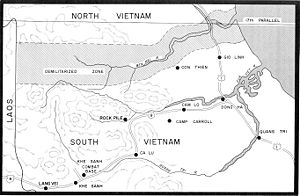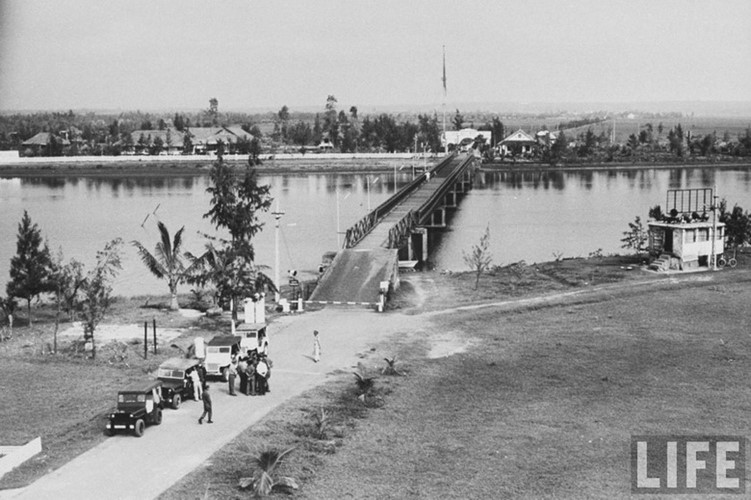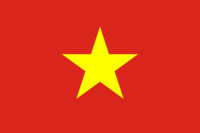Vietnamese Demilitarized Zone (DMZ) at the 17th Parallel
The Vietnamese Demilitarized Zone at the 17th Parallel (commonly known internationally as the Vietnamese Demilitarized Zone – V-DMZ) is a demilitarized zone established along the banks of the Ben Hai River on July 21, 1954, according to the Geneva Accords on Indochina in 1954.
Its original purpose was to serve as a temporary military demarcation line to separate the forces of the Democratic Republic of Vietnam (North Vietnam) from the French military and their allies. In principle, this Vietnamese Demilitarized Zone demilitarized zone extended 1.6 kilometers (one mile) on each side from the banks of the Ben Hai River, starting from the Vietnam-Laos border to the coast of the East Sea (South China Sea).
The temporary demarcation line was expected to be removed after the general elections scheduled for two years later. However, it became a practical border dividing Vietnam throughout the war. On July 2, 1976, the National Assembly of Vietnam officially abolished the existence of the DMZ when the Socialist Republic of Vietnam was established under the absolute leadership of the Communist Party of Vietnam.

Vietnamese Demilitarized Zone history
Origins After World War II, the French made efforts to reassert control over their former colony in Indochina. However, they faced fierce resistance from nationalist forces, including those led by Ho Chi Minh and his communist allies. The war lasted for nine years and ended with a clear advantage for the communist forces of North Vietnam, forcing the French to seek a diplomatic solution through the Geneva Accords on Indochina in 1954, an undesired compromise that would eventually lead to their withdrawal from Indochina.
During the negotiations, the Democratic Republic of Vietnam understood that they needed to take advantage of the negotiation process to gain favorable terms without bloodshed. Initially, they wanted to concentrate at their current locations since they had the advantage in terms of population and territory control (over 80% of the land). However, realizing that the French would not accept this proposal, they shifted to accepting a temporary military demarcation line. They hoped that the temporary demilitarized zone would allow both sides to move their forces further south. Initially, they intended to propose the 13th parallel, which was north of Phu Yen, or the 14th parallel (Binh Dinh) as the basis for their territorial control in the vast mountainous region. However, this proposal was rejected by the French. According to the French, the 19th parallel, north of Vinh, Nghe An, would be more suitable. At this point, the Viet Minh wanted to control Hue, Da Nang, and the Central Highlands, strategic and symbolic areas.
Faced with the unwavering stance of the Democratic Republic of Vietnam delegation, on June 24, 1954, the French proposed the 18th parallel (north of Dong Hoi – Quang Binh), citing the need for a transportation route through Laos, specifically National Route 9. The Viet Minh still did not yield. The conference remained deadlocked for 18 days.
The conference only resumed when China, the ally of the Democratic Republic of Vietnam, exerted pressure on the delegation to propose the 16th parallel (Da Nang), a location that the Allied nations had delineated in 1945 to divide the area of Japanese occupation in Indochina. They also committed to hold general elections within 6 months. Once again, the French rejected this proposal and put forward their own proposal for the 18th parallel and only accepted the principle of general elections with vague terms.
It was not until July 20, 1954, that both the French and the Democratic Republic of Vietnam approved the Soviet Union’s proposal to choose the 17th parallel and set a time frame for general elections within 2 years. On the following day, Wednesday, July 21, 1954, the Geneva Accords were signed. Accordingly, Vietnam was divided into two military-administrative zones; the border was the 17th parallel (Ben Hai River), not recognized as a national or political border. A Vietnamese Demilitarized Zone, no more than 5 kilometers wide on each side from the demarcation line, came into effect on August 14, 1954.
The Democratic Republic of Vietnam was not satisfied because it believed it deserved control over a much larger area and the opportunity to take control of the entire country. However, under pressure from its allies, it had to accept the compromise of the “17th parallel” and the promise of a unified general election after 2 years. Although they anticipated this, they could not have foreseen that it would lead to 20 years of division and a fierce war.
Provisions of the V-DMZ After 8 plenary sessions and 23 smaller meetings, on July 21, 1954, the Agreement on the Cessation of Hostilities in Vietnam was officially signed by the four countries involved: the Democratic Republic of Vietnam (DRV), the French Union (representing France), the People’s Republic of China (PRC), and the Union of Soviet Socialist Republics (USSR). It consisted of 10 basic provisions:
- The establishment of the 17th parallel as a provisional military demarcation line temporarily dividing Vietnam into two zones, pending unification on the basis of internationally supervised general elections.
- A temporary demilitarized zone no wider than 5 kilometers on either side of the 17th parallel.
- A cease-fire to take effect on July 20, 1954, at 11:00 AM Saigon time.
- The withdrawal of all French Union forces from Vietnam north of the 17th parallel, to be completed by May 1955.
- The withdrawal of all DRV forces from Vietnam south of the 17th parallel, to be completed by May 1955.
- The territorial integrity and sovereignty of Vietnam were to be respected by all parties.
- The non-introduction of foreign troops into Vietnam after the cease-fire.
- Free movement of civilians between the two zones to be allowed for a 300-day period, during which they could choose to live in either zone.
- Supervision of the cease-fire and other provisions by an International Control Commission (ICC) consisting of Canada, India, and Poland.
- International supervision of elections to be held in July 1956, to reunify Vietnam under a single government.
These provisions were meant to be a temporary solution to end the hostilities and pave the way for reunification through elections. However, the subsequent history of the Vietnam War, the involvement of outside powers, and the deepening of the Cold War would prevent the peaceful reunification of Vietnam as envisioned in the Geneva Accords.

The Role of the Vietnamese Demilitarized Zone (DMZ) in the Vietnam War
During the Vietnam War (1955-1975), the Demilitarized Zone (DMZ) became a focal point for military operations. It was intended to be a buffer zone separating North Vietnam from South Vietnam, but it became one of the most heavily fortified and fought-over areas in the conflict. Key points and events related to the DMZ during the war include:
- The Ben Hai River: The Ben Hai River marked the approximate location of the 17th parallel and served as a natural boundary. The DMZ was established around this river, with a width of about 5 kilometers (3 miles) on either side.
- The McNamara Line: The U.S. military constructed a barrier known as the McNamara Line, named after U.S. Secretary of Defense Robert McNamara, which consisted of various defensive structures and obstacles designed to prevent infiltration from North Vietnam into the south. These included barbed wire fences, minefields, and electronic sensors.
- Khe Sanh: The Khe Sanh Combat Base, located just south of the DMZ, was the site of a major battle in early 1968. It was surrounded and besieged by North Vietnamese forces for several months, becoming one of the most iconic episodes of the war.
- Con Thien: This U.S. Marine combat base, situated near the DMZ, saw significant fighting and was the site of artillery duels with North Vietnamese forces.
- Operation Hastings: This was a U.S. and South Vietnamese military operation conducted near the DMZ in July 1966, aimed at disrupting North Vietnamese infiltration routes.
- The Easter Offensive: In 1972, North Vietnam launched a major offensive across the DMZ as part of their effort to gain control of South Vietnam. This offensive led to intense fighting in the region.
- Impact on Civilians: The establishment of the DMZ and the military operations in the area had a significant impact on the civilian population living in the region. Many people were displaced, and the area suffered extensive environmental damage.
- End of the War: The DMZ lost its military significance after the signing of the Paris Peace Accords in 1973, which led to the withdrawal of U.S. forces from Vietnam. The DMZ was officially dissolved on July 2, 1976, following the reunification of North and South Vietnam.

In summary, the Demilitarized Zone (DMZ) at the 17th Parallel, established by the Geneva Accords in 1954, was intended to be a temporary division between North and South Vietnam, with the goal of reunification through elections. However, it became a major focal point of military activity during the Vietnam War, and it was only dissolved after the war ended with the reunification of Vietnam in 1975. The DMZ played a significant role in the history of the conflict and is remembered for the intense battles and challenges it presented. Today, some areas of the former Vietnamese Demilitarized Zone have been transformed into historical sites and tourist destinations in Vietnam.
To get to Vietnamese Demilitarized Zone, tourist can take Hue to DMZ by private car with English speaking driver

